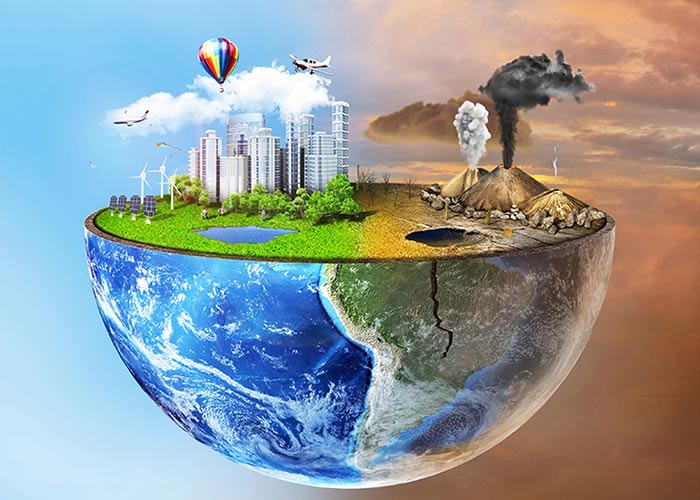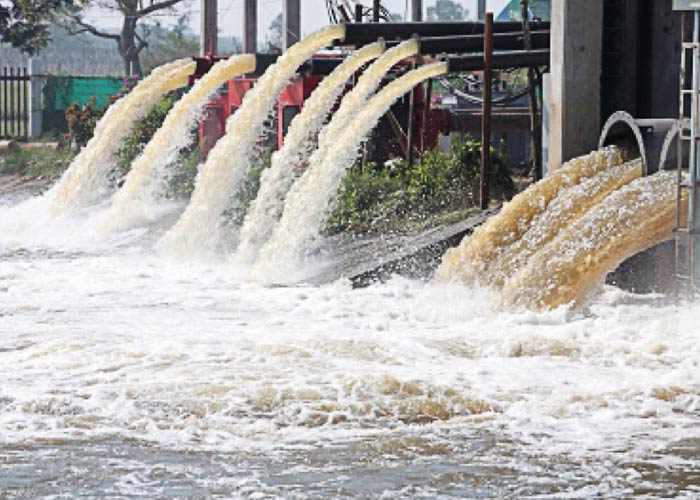The unwanted changes or variations in the physical, biological or chemical properties of the soil, which have an adverse effect on the organisms or plants is called soil pollution. It greatly harms the natural quality and utility of the soil.
Degradation in the quality of the soil implies the rapid erosion of soil by wind or aquatic actions, deficiency of micro-organisms living in the soil, the decline or increase in moisture in the soil beyond normal limits, excessive ups and downs in the temperature, lack of humus in the soil, and the excessive growth in the amount of pollutants in the soil.
The natural sources of soil pollution include volcanic eruptions, landslides and rainfall, whereas human causes include use industrial waste, urban garbage, excessive mining and reckless use of chemicals and insecticides in agriculture.
Significance of Soil
Soil is the prime and valuable property obtained through nature. It is a major contribution to the life of humans and animals for whom it’s a source of water, energy and food attainment. It is the source of the food for all the people living on Earth, the creatures as well as the vegetation.
If the soil is healthy and pollution free, then all the flora, fruits and vegetables produced from its womb will also get clean. If we irrigate vegetables and fruits by using the polluted water of the factories, sewers and acid rain due to pollution, the result are nothing but harmful to our health. So, soil pollution affects humans, organisms and flora directly and indirectly.
- Effects of Soil Pollution on Soil Fertility
Soil Pollution has adverse effects on the well-being of humans, plants and animals. Due to flood water, over-utilization of chemical fertilizers, pesticides and bacterial killers and excessive use of land due to multi-cropping system, so many distortions occur in the soil that it tends to lose its essential structure and element to maintain its fertility. The side effects of soil pollution include severe depletion of certain types of calcium, methane, nitrogen, sulphur, iron, copper, nitrogen, potassium and phosphorus in the soil; destruction of some useful plants and organisms which give moisture to the soil; toxic grains, vegetables and fruit that pose health problems to humans and alkalinity in the soil.
Soil pollution can reduce the yields of crops and plants. It causes the loss of soil and natural nutrients, leading to decrease in crop production. The ‘chemical farming’ adopted for green revolution or advanced yield is rather wasting it permanently instead of increasing soil fertility.
The physical and chemical properties of the soil are affected by soil pollution. Generally solid waste is buried under the soil. This leads to the loss of non-renewable metals such as copper, zinc, lead etc, and adverse impact on the production capacity of the soil. People sometimes irrigate farms with sewage water. This reduces the number of holes present in the soil day by day. Later, a situation comes that the natural sewage treatment system of the land is completely destroyed. When the land reaches such a situation, it is called a sick land.
- Phenomenon of Soil Erosion
Regular new construction and deforestation taking place on fertile land has accelerated the process of flood and soil erosion. Erosion itself is responsible for soil pollution. It takes 100 to 400 years to build up to 10 centimetre of upper soil. So, the destruction of soil is in a way loss of limited and non-renewal property.
In India, the population is growing faster than our resources, so we need more yield. Due to indiscriminate use of chemical fertilizers in the fields, lack of time difference in the production of two crops, soil pollution is increasing. In addition to it, continuous erosion of trees is also a major reason for soil pollution and environmental imbalance. Soil erosion is also leading to frequent floods and droughts.
- Impact on water sources
When the quantity of polluted substances increases in the soil, they reach the water sources and increase the concentration of salts and other harmful substances in them, as a result of which such water sources are not able to provide potable water. Dirt contaminated with high level nitrogen and phosphorus is stored in the waterway. As a result, aquatic plants die due to lack of oxygen.
- Impact on animal and human health
Soil is an important and vibrant unit in our ecosystem. One gram fertile soil contains about 100 million bacteria and fungus equivalent to 500 meters. In addition, soil system is also a refuge site for thousands of other types of algae cells, viruses, arthropods, and other organisms such as earthworms. The use of chemicals, pesticides and toxic elements to increase the nutrition power of soil adversely affects the health of animals and humans through dietary cycle.
Due to the excess of waste and dirt in the soil, growing number of insects are generated in them. As a result, the production of mosquito, fly, insects, rats, scorpions and snakes increases, which causes diseases such as dysentery, cholera, gastroenteritis, typhoid, liver disease, jaundice etc.
- The Problem of E-Waste
Nowadays another pollutant that has made its presence felt in the world is e-waste. Electronic devices are now part of the modern lifestyles. Earlier in general, the garbage was generated out of the newspaper, old clothes, iron etc, but now with old CDs, TVs, ovens, refrigerators, laptops, keyboards, mouse, condenser, microchips, computers, electronic toys and many plastic items, there is an accumulation of e-waste.
We may not even know that our kidney and liver are affected by harmful chemicals from out-of-use electronic equipment, and diseases like cancer and paralysis are also increased. This e-waste affects the soil, water and air with diseases. Together with toxic chemicals and gaseous formations, the land becomes barren and poisonous; through vegetables, fruits and crops; poisonous substances grown in water and air reach our body and make us sick.
According to Global E-Waste Monitoring-2014, a United Nations report released in April 2015, India is at the fifth place in the world in spreading e-waste. This report says that the waste spread by electronic equipment in the next three years is likely to increase up to 21%. Worldwide, 4-18 million tonnes of e-waste was produced in the year 2014, and the highest number of e-waste in the world was found in Asia. It is estimated that by 2018 this will go up to 50 million tonnes. Green computing is essential for this solution, i.e., proper disposal of these electronic devices. Today these tools are becoming a challenge for the environment.
The disposal of e-waste is, in fact, the biggest problem. Therefore, we should promote green computing through the use of computers and related resources in green environment. There are many advantages of this: one can reduce global warming and reduce the electricity bill. If a computer is running 24 hours on an average, it costs an average of Rs. 6000 to Rs. 8500 for the entire year, and the carbon dioxide emitted from it, which is approximately 680 kilograms, dissolves in the environment. If the computer is shut down at night, the quantity of carbon dioxide emanating from it will be approximately 340 kg, i.e., half and half of the electricity bill will also be saved. Due to less pollution, there will also be a reduction in diseases which will save the cost of medicines and reduce the risk of life.
Conclusion
Soil pollution adversely affects the quality and the fertility of soil from human-born sources or natural sources. If the fundamental properties of soil fall, then its production capacity decreases. The growth of crops and vegetation is reduced and the land is converted to barren and rugged land. What is produced is not eatable due to pollution. Whether the pollution is in air or water, its impact is felt on the soil. In recognition of the promotion of soil science and soil resource conservation made by King Bhumibol Adulyadej of Thailand, the King’s birthday, December 5 is celebrated as ‘World Soil Day’. The United Nations Food and Agriculture Organization (FAO), through this day, acknowledge soil’s significance as a critical component of the natural system and as a crucial contributor to the wellbeing of human, animal and plant life.
Today, there is a crying need to take a resolution for “Going Green”, as it is necessary to take control over the growing soil pollution. Soil is the farmer’s gold. If its quality decreases, then the economy of India and our food plate too will feel the same adverse impact. Agriculture without healthy soil cannot be the basis of the country’s economy. It implies that if we think about doing anything – increasing food production – first of all, we should see its impact on farmers, and the poor people, i.e., whether they will get any benefit or not. It is also necessary to do the management and disposal of liquid and solid residues from the factories. Let us reduce e-waste, go for plantation, and control factors that increase soil pollution and desist from flowing sewer water in the river, which is the lifeline of mankind.
More on Soil Pollution
Causes and Sources of Soil Pollution







